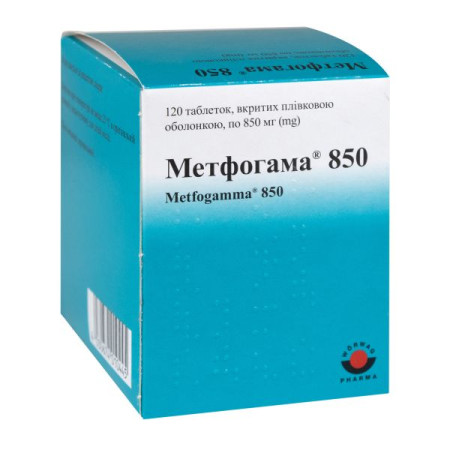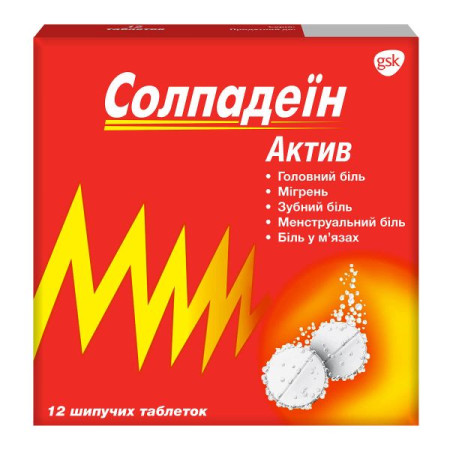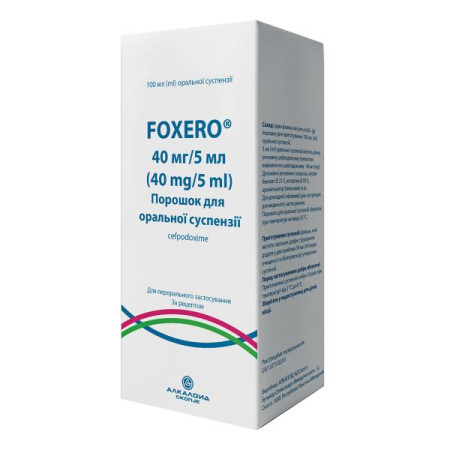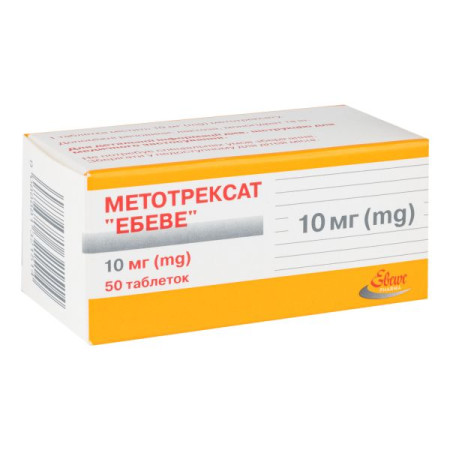Metamin film-coated tablets 850 mg No. 100

Instructions for use: Metamin film-coated tablets 850 mg No. 100
Composition
active ingredient: metformin hydrochloride;
1 tablet contains metformin hydrochloride 500 mg or 850 mg or 1000 mg;
Excipients: lactose monohydrate, povidone, magnesium stearate, colloidal anhydrous silicon dioxide, hydroxypropylmethylcellulose.
Dosage form
Film-coated tablets.
Main physicochemical properties:
500 mg, 850 mg tablets: white or almost white, round, biconvex, smooth tablets on both sides;
1000 mg tablets: white or almost white, oval-shaped, biconvex, smooth on both sides.
Pharmacotherapeutic group
Oral hypoglycemic agents, except insulins. Biguanides. ATX code A10B A02.
Pharmacological properties
Pharmacodynamics
Metformin is a biguanide with antihyperglycemic effect. It reduces both the initial and postprandial glucose levels in the blood plasma. It does not stimulate insulin secretion and does not cause a hypoglycemic effect.
Metformin works in three ways:
– leads to a decrease in glucose production in the liver due to inhibition of gluconeogenesis and glycogenolysis;
– improves insulin sensitivity in muscles by improving peripheral glucose uptake and utilization;
– delays the absorption of glucose in the intestine.
Metformin stimulates intracellular glycogen synthesis by acting on glycogen synthetase. Increases the transport capacity of all types of membrane glucose transporters (GLUT).
Regardless of its effect on glycemia, metformin has a positive effect on lipid metabolism: it reduces total cholesterol, low-density lipoproteins, and triglycerides.
In clinical trials, patients' body weight remained stable or moderately decreased during the use of metformin. In addition to its effect on glycemia, metformin has a beneficial effect on lipid metabolism. When taking the drug in therapeutic doses during controlled, medium- and long-term clinical trials, it was noted that metformin reduces the levels of total cholesterol, low-density lipoproteins and triglycerides.
Pharmacokinetics
Absorption. After oral administration of metformin, the time to maximum concentration (Tmax) is approximately 2.5 hours. The absolute bioavailability of 500 mg or 850 mg tablets is approximately 50-60% in healthy volunteers. After oral administration, the fraction that is not absorbed and is excreted in the feces is 20-30%.
After oral administration, the absorption of metformin is saturable and incomplete.
The pharmacokinetics of metformin absorption are expected to be non-linear. At recommended metformin doses and dosing regimens, steady-state plasma concentrations are achieved within 24-48 hours and are less than 1 μg/ml. In controlled clinical trials, maximum metformin plasma levels (Cmax) did not exceed 5 μg/ml even at maximum doses.
When taken with food, the absorption of metformin is reduced and slightly delayed.
Following oral administration of an 850 mg dose, there was a 40% decrease in peak plasma concentration, a 25% decrease in AUC, and a 35-minute increase in time to peak plasma concentration. The clinical significance of these changes is unknown.
Distribution. Plasma protein binding is negligible. Metformin penetrates into erythrocytes. Peak blood concentrations are lower than peak plasma concentrations and are reached at approximately the same time. Erythrocytes are likely to represent a second distribution compartment. The mean volume of distribution (Vd) ranges from 63 to 276 L.
Metabolism: Metformin is excreted unchanged in the urine. No metabolites have been identified in humans.
Elimination: Renal clearance of metformin is > 400 ml/min, indicating that metformin is eliminated by glomerular filtration and tubular secretion. After an oral dose, the elimination half-life is approximately 6.5 hours. In cases of impaired renal function, renal clearance decreases in proportion to creatinine clearance and therefore the elimination half-life increases, leading to increased metformin plasma levels.
Indication
Type II diabetes mellitus with ineffective diet therapy and exercise regimen, especially in patients with excess body weight;
- as monotherapy or combination therapy in combination with other oral hypoglycemic agents or in combination with insulin for the treatment of adults.
- as monotherapy or combination therapy with insulin for the treatment of children aged 10 years and older and adolescents.
To reduce the complications of diabetes in adult patients with type 2 diabetes mellitus and overweight as a first-line drug after ineffective diet therapy.
Contraindication
– Hypersensitivity to metformin or any other component of the drug;
– diabetic ketoacidosis, diabetic precoma;
– acute conditions that occur with a risk of developing kidney dysfunction, such as: dehydration, severe infectious diseases, shock;
– diseases that can lead to the development of hypoxia (especially acute diseases or exacerbation of a chronic disease): decompensated heart failure, respiratory failure, recent myocardial infarction, shock;
– liver failure, acute alcohol poisoning, alcoholism.
Interaction with other medicinal products and other types of interactions
Combinations that are not recommended for use.
Alcohol. Acute alcohol intoxication is associated with an increased risk of lactic acidosis, especially in cases of fasting or low-calorie diet, as well as in liver failure. When treating with Metamin®, alcohol and medications containing alcohol should be avoided.
Iodinated radiocontrast agents: Intravenous administration of iodinated radiocontrast agents may lead to renal failure and, as a result, metformin accumulation and an increased risk of lactic acidosis.
In patients with GFR > 60 ml/min/1.73 m2, metformin should be discontinued prior to or at the time of the test and not resumed until 48 hours after the test, only after re-evaluation of renal function and confirmation of no further deterioration of renal function (see section 4.4).
In patients with moderate renal impairment (GFR 45-60 mL/min/1.73 m2), metformin should be discontinued 48 hours prior to the administration of iodinated radiocontrast agents and not resumed until 48 hours after the examination, only after re-evaluation of renal function and confirmation of no further deterioration of renal function.
Combinations that should be used with caution.
Drugs that have a hyperglycemic effect (glucocorticosteroids of systemic and local action, sympathomimetics, chlorpromazine). It is necessary to monitor the blood glucose level more often, especially at the beginning of treatment. During and after discontinuation of such concomitant therapy, it is necessary to adjust the dose of Metamin under the control of the glycemia level.
ACE inhibitors may lower blood glucose levels. If necessary, the dosage of the drug should be adjusted during concomitant therapy.
Diuretics, especially loop diuretics, may increase the risk of lactic acidosis due to possible decreased renal function.
Application features
Lactic acidosis is a very rare but serious metabolic complication (high mortality rate in the absence of urgent treatment) that can occur as a result of metformin accumulation. Cases of lactic acidosis have been reported in diabetic patients with renal failure or acute deterioration of renal function. Caution should be exercised in cases where renal function may be impaired, for example, in cases of dehydration (severe diarrhea or vomiting), or at the beginning of treatment with antihypertensive agents, diuretics and at the beginning of therapy with nonsteroidal anti-inflammatory drugs (NSAIDs). In the event of these exacerbations, metformin should be temporarily discontinued.
Other risk factors for lactic acidosis should be considered: poorly controlled diabetes mellitus, ketosis, prolonged fasting, excessive alcohol consumption, hepatic insufficiency or any condition associated with hypoxia (decompensated heart failure, acute myocardial infarction) (see section "Contraindications").
Lactic acidosis may manifest as muscle cramps, indigestion, abdominal pain and severe asthenia. Patients should immediately inform their doctor about the occurrence of such reactions, especially if they have previously tolerated metformin well. In such cases, metformin should be temporarily discontinued until the situation is clarified. Metformin therapy should be resumed after assessing the benefit/risk ratio in individual cases and assessing renal function.
Diagnostics. Lactic acidosis is characterized by acidotic dyspnea, abdominal pain, and hypothermia, and may progress to coma. Diagnostic indicators: laboratory decrease in blood pH, increase in serum lactate concentration above 5 mmol/L, increase in anion gap, and lactate/pyruvate ratio.
In case of lactic acidosis, the patient should be hospitalized immediately (see section "Overdose"). The physician should warn patients about the risk of developing and the symptoms of lactic acidosis.
Renal failure. Since metformin is excreted by the kidneys, creatinine clearance (can be estimated from the level of blood plasma creatinine using the Cockcroft-Gault formula) or GFR should be checked before starting and regularly during treatment with Metamin®:
– patients with normal kidney function – at least once a year;
– patients with creatinine clearance at the lower limit of normal and elderly patients – at least 2-4 times a year.
Decreased renal function is common in the elderly and is asymptomatic. Caution should be exercised in situations where renal function may be impaired, such as dehydration or at the beginning of treatment with antihypertensive agents, diuretics and at the beginning of therapy with non-steroidal anti-inflammatory drugs (NSAIDs). In such cases, it is also recommended to check renal function before starting treatment with metformin.
Cardiac function. Patients with heart failure are at increased risk of hypoxia and renal failure. Metformin may be used in patients with stable chronic heart failure with regular monitoring of cardiac and renal function. Metformin is contraindicated in patients with acute and unstable heart failure (see section 4.3).
Iodinated radiocontrast agents. Intravenous administration of radiocontrast agents for radiological examinations may cause renal failure, and as a result lead to metformin accumulation and an increased risk of lactic acidosis. In patients with a GFR > 60 ml/min/1.73 m2, metformin should be discontinued prior to or at the time of the examination and not resumed until 48 hours after the examination, only after re-evaluation of renal function and confirmation of the absence of further deterioration of renal function (see section 4.5).
In patients with moderate renal impairment (GFR 45-60 ml/min/1.73 m2), metformin should be discontinued 48 hours before the administration of iodinated radiocontrast agents and not resumed earlier than 48 hours after the examination, only after re-evaluation of renal function and confirmation of the absence of further deterioration of renal function (see section 4.5).
Surgery: Metamin should be discontinued 48 hours before elective surgery performed under general, spinal, or epidural anesthesia and not resumed until 48 hours after surgery or resumption of oral nutrition and only if renal function is normal.
Children. Type 2 diabetes mellitus should be confirmed before starting metformin therapy. Metformin has not been shown to affect growth and sexual maturation in children. However, there are no data on the effects of metformin on growth and sexual maturation with longer-term use of metformin, so careful monitoring of these parameters is recommended in children treated with metformin, especially during puberty.
Children aged 10 to 12 years. The efficacy and safety of metformin in patients of this age did not differ from that in older children and adolescents. The drug should be prescribed with particular caution in children aged 10 to 12 years.
Other precautions: Patients should follow a diet, maintain a balanced carbohydrate intake throughout the day, and monitor laboratory parameters. Overweight patients should continue to follow a low-calorie diet. Carbohydrate metabolism should be monitored regularly.
Metformin monotherapy does not cause hypoglycemia, but caution should be exercised when metformin is used concomitantly with insulin or other oral hypoglycemic agents (e.g., sulfonylureas or meglitinides).
Fragments of the tablet shell may be present in the feces. This is normal and has no clinical significance.
If the patient has been diagnosed with an intolerance to some sugars, contact your doctor before taking this medicinal product, as the product contains lactose.
Use during pregnancy or breastfeeding
Pregnancy. Uncontrolled diabetes during pregnancy (gestational or permanent) increases the risk of congenital anomalies and perinatal mortality. There are limited data from the use of metformin in pregnant women, which do not indicate an increased risk of congenital anomalies. Preclinical studies have not revealed any adverse effects on pregnancy, embryonal or foetal development, labour and postnatal development. In cases of planning pregnancy, as well as in cases of pregnancy, it is recommended to use insulin, not metformin, to treat diabetes to maintain blood glucose levels as close to normal as possible, in order to reduce the risk of foetal malformations.
Breastfeeding. Metformin is excreted in human milk, but no adverse effects have been observed in breastfed newborns/infants. However, due to insufficient data on the safety of the drug, breastfeeding is not recommended during metformin therapy. A decision on whether to discontinue breastfeeding should be made taking into account the benefit of breastfeeding and the potential risk of adverse effects to the child.
Fertility: Metformin had no effect on male or female fertility at doses of 600 mg/kg/day, which is almost three times the maximum recommended daily human dose based on body surface area.
Ability to influence reaction speed when driving vehicles or other mechanisms
Monotherapy with metformin does not affect the speed of reactions when driving or working with other mechanisms, since the drug does not cause hypoglycemia.
However, caution should be exercised when using metformin in combination with other hypoglycemic agents (sulfonylureas, insulin or meglitidines) due to the risk of hypoglycemia.
Method of administration and doses
Adults.
Monotherapy or combination therapy compatible with other oral hypoglycemic agents.
The usual starting dose is 500 mg or 850 mg (Metamin®, film-coated tablets, 500 mg or 850 mg) 2-3 times daily during or after meals.
After 10-15 days, the dose should be adjusted according to the results of serum glucose measurements.
Slowly increasing the dose helps reduce side effects from the digestive tract.
When treating with high doses (2000-3000 mg per day), it is possible to replace every 2 tablets of Metamin®, 500 mg, with 1 tablet of Metamin®, 1000 mg.
The maximum recommended dose is 3000 mg per day, divided into 3 doses.
In case of switching from another antidiabetic agent, this agent should be discontinued and metformin should be prescribed as described above.
Combination therapy is compatible with insulin.
To achieve better blood glucose control, metformin and insulin can be used as combination therapy. The usual starting dose is 500 mg or 850 mg of Metformin® 2-3 times daily, while the insulin dose should be adjusted according to blood glucose measurements.
Children.
Monotherapy or combination therapy compatible with insulin.
Metamin® is intended for use in children aged 10 years and older and adolescents. The usual starting dose is 500 mg or 850 mg of Metamin® once daily during or after meals. After 10-15 days, the dose should be adjusted based on serum glucose measurements.
Slowly increasing the dose helps reduce side effects from the digestive tract.
The maximum recommended dose is 2000 mg per day, divided into 2-3 doses.
Elderly patients may have decreased renal function, therefore the dose of metformin should be selected based on assessment of renal function, which should be performed regularly (see section "Special instructions").
Patients with renal impairment. Metformin can be used in patients with moderate renal impairment, stage IIIa (creatinine clearance 45-59 ml/min or GFR 45-59 ml/min/1.73 m2) only in the absence of other conditions that may increase the risk of lactic acidosis, with the following dose adjustment: the initial dose is 500 mg or 850 mg of metformin hydrochloride once daily. The maximum dose is 1000 mg per day and should be divided into 2 doses. Renal function should be closely monitored (every 3-6 months).
If creatinine clearance or GFR decreases to < 45 mL/min or 45 mL/min/1.73 m2, respectively, metformin should be discontinued immediately.
Children
The drug Metamin® is used to treat children aged 10 years and older.
Overdose
When using the drug in a dose of 85 g, hypoglycemia was not observed. However, in this case, lactic acidosis developed. In the event of lactic acidosis, treatment with Metamin should be discontinued and the patient urgently hospitalized. The most effective measure for removing lactate and metformin from the body is hemodialysis.
Adverse reactions
Metabolic and nutritional disorders: lactic acidosis (see section "Special warnings and precautions for use").
With prolonged use of the drug in patients with megaloblastic anemia, vitamin B12 absorption may decrease, which is accompanied by a decrease in its level in the blood serum. It is recommended to consider this possible cause of B12 hypovitaminosis if the patient has megaloblastic anemia.
From the nervous system: taste disturbance.
From the digestive tract: nausea, vomiting, diarrhea, abdominal pain, lack of appetite. Most often, these side effects occur at the beginning of treatment and, as a rule, disappear spontaneously. To prevent the occurrence of side effects from the digestive tract, it is recommended to slowly increase the dose of the drug and use the drug 2-3 times a day during or after meals.
On the part of the hepatobiliary system: liver function tests or hepatitis, which completely disappear after metformin withdrawal.
Skin and subcutaneous tissue disorders: allergic skin reactions, including rash, erythema, pruritus, urticaria.
Expiration date
3 years.
Storage conditions
Store at a temperature not exceeding 25 °C in the original packaging.
Keep out of reach of children.
Packaging
Tablets 500 mg, 850 mg: 10 tablets in a blister. 3 or 10 blisters in a cardboard box.
1000 mg tablets: 15 tablets in a blister. 2 or 6 blisters in a cardboard box.
Vacation category
According to the recipe.
Producer
"KUSUM FARM" LLC.
Location of the manufacturer and address of its place of business
40020, Ukraine, Sumy region, Sumy city, Skryabina st., 54.
There are no reviews for this product.
There are no reviews for this product, be the first to leave your review.
No questions about this product, be the first and ask your question.













